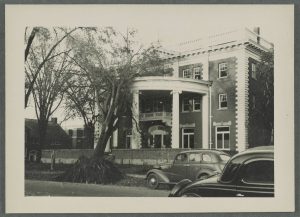Our series examining an Image of the Week from the photographic files, by Kevin Warstadt, Digital Program Specialist.
Pictured above is an image from a folder titled “U.S.S. Rogers Blood.”
The U.S.S. Rogers Blood was a destroyer escort commissioned in 1945, sponsored by the Blood family. It was reclassified a fast transport in 1945 under the command of Commander John W. Higgins, Jr. The ship’s namesake was First Lieutenant Rogers Blood of Manchester, New Hampshire.
Blood was described as an active member of student life at Manchester Central High School, with involvement in various leadership roles and athletics. He enrolled at Dartmouth in 1940 and enlisted in the Marine Corp Reserve in 1942. He accepted a commission as Second Lieutenant in 1943 and was promoted to first Lieutenant in 1944.
Blood was killed in action on Engebi Island in 1944, leading his platoon in a charge against a fortified enemy position. He received the Silver Star posthumously for his courage in battle.
The U.S.S. Rogers Blood was decommissioned in 1946 and berthed in Green Cove Springs, Florida. It was sold and disposed of in 1961.
See more World War II images in the Dartmouth photographic files.



